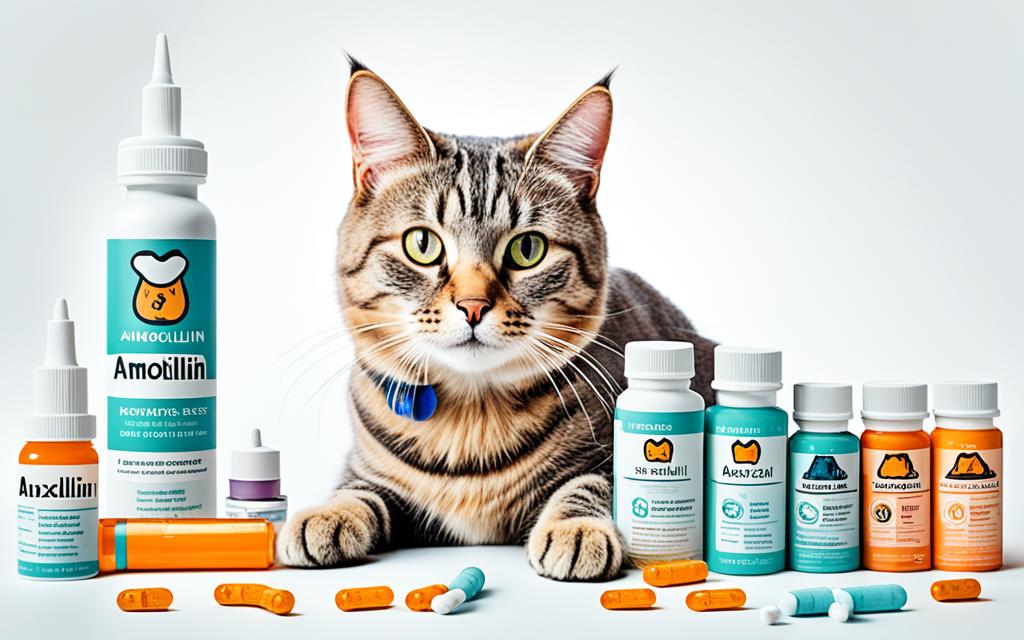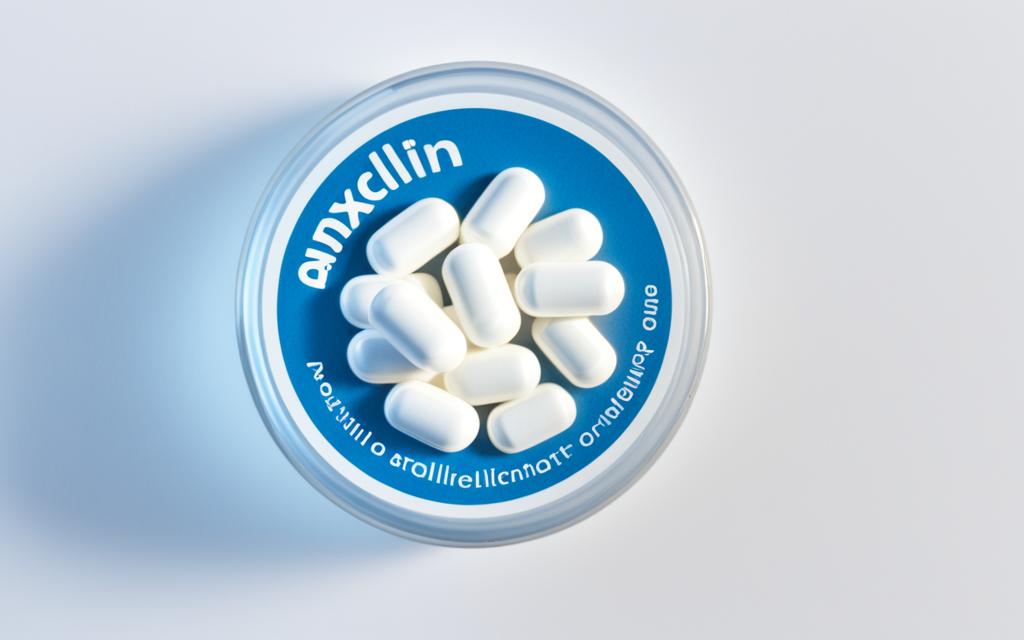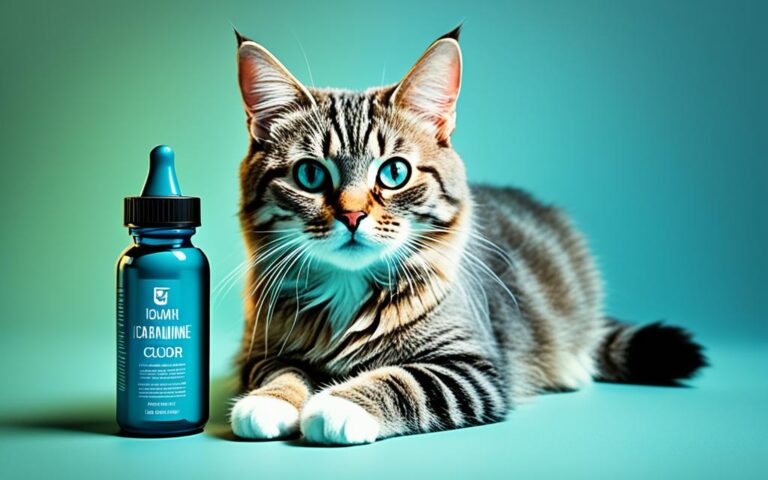Amoxicillin for cats: Uses, Side Effects, and Dosage Guide
Amoxicillin is a vital antibiotic for our feline friends. A huge1 99% of cats who take amoxicillin get better from their bacterial infections. It’s approved by the FDA for many types of infections in cats.
It’s critical to know the right way to use amoxicillin for your cat. Learning about the correct dosage and possible side effects can keep your cat safe.
We will explore how this antibiotic can help your furry friend. This guide is here to help you keep your cat healthy.
Key Takeaways
- Amoxicillin is a common and effective antibiotic for treating bacterial infections in cats.
- The recommended dosage is 10-25 mg/kg every 12 hours, typically for 3-5 days or up to a few weeks.
- Common side effects include digestive issues like vomiting, diarrhea, and loss of appetite.
- Amoxicillin can interact with other medications and should be used cautiously in pregnant or lactating cats.
- Proper administration and completing the full course of treatment are essential to prevent antibiotic resistance.
Table of Contents
What is Amoxicillin for Cats?
Amoxicillin is a part of the penicillin family2. It works to kill bacteria by attacking their cell walls. This makes the bacteria weak and eventually die3. It specifically fights bacteria that don’t have a certain enzyme. If bacteria have this enzyme, they can resist amoxicillin.
Understanding Amoxicillin’s Mechanism of Action
This drug interferes with making the bacterial cell wall. Because the cell wall can’t finish growing, it breaks apart. This causes the bacteria to die2.
Benefits of Amoxicillin for Feline Bacterial Infections
In cats, amoxicillin is used to treat many bacterial infections. These can affect the respiratory or urinary tract, the gut, and the skin3. It starts working quickly, usually within a few hours after the cat takes it3. Sometimes, vets might use it for infections not listed, which is called off-label use2.
It’s often given to cats with skin, respiratory, or urinary infections3. In a study of 122 cats with wounds, amoxicillin cleared the infection in over 95% of cases4. It’s also better at treating some urinary infections than other drugs, according to the Merck Manual4.
“Amoxicillin is a versatile antibiotic that can effectively treat a wide range of bacterial infections in cats, making it a valuable tool in the veterinarian’s arsenal.”
Most cats tolerate amoxicillin well. But, there can be side effects. It’s key to use it as your vet says342.
Common Uses of Amoxicillin in Cats
Amoxicillin is a go-to antibiotic for many bacterial infections in cats5. It fights off germs in the urinary tract, gut, and lungs, as well as skin issues6.
Urinary Tract Infections
This antibiotic is key for curing UTIs in cats5. It handles common UTI bacteria like Staphylococcus, Streptococcus, and E. coli5.
Gastrointestinal Bacterial Infections
If your cat’s stomach disease is from Helicobacter, amoxicillin can help5. This bacteria can hurt the stomach lining but amoxicillin fights back5.
Upper Respiratory Tract Infections
Amoxicillin is great for certain throat and lung issues in cats56. It works against the bacteria causing tonsillitis and tracheobronchitis5.
Skin and Soft Tissue Infections
Skin troubles, from infections to cuts, and even abscesses respond well to amoxicillin57. It battles bacteria like Staphylococcus or Streptococcus efficiently57.
Vets and cat owners should know how amoxicillin is commonly used. This understanding helps in picking the right care for felines576.

Always, the advice of a vet should guide amoxicillin use in cats. Wrong amounts or ways of giving it can be risky6.
Amoxicillin for Cats: Forms and Administration
Amoxicillin is a common antibiotic for cats used to fight off bacterial infections8. It’s often given as a liquid that’s easily taken by cats, especially the Amoxi-Drop brand, kept in the fridge8. This form is preferred because giving it to cats is simple compared to pills or capsules8.
Cat owners might also find amoxicillin in tablet or capsule forms8. These can be harder to give to cats but works well for some8. There’s also an injectable kind, mostly used in vet clinics8.
The best type of amoxicillin depends on the cat’s needs and what the vet suggests8. Things like the cat’s health, size, and the infection type matter when choosing a form8.
| Amoxicillin Form | Advantages | Disadvantages |
|---|---|---|
| Liquid Suspension | – Easier to give to cats – Good for exact dosing | – Must be kept cool – Shake well before use |
| Tablets or Capsules | – Handy for cat owners – Last longer | – Can be tough to give to cats |
| Injectable | – Exact doses – For serious illnesses | – Only for use by vets – May be uncomfortable for cats |
It’s very important to follow the vet’s directions closely when giving amoxicillin to your cat8. This helps make sure they get the right amount and it works well. Giving it correctly keeps your cat healthy and stops antibiotics from not working later8.
To wrap up, amoxicillin comes in a few different types for cats8. The liquid kind is usually the first choice because it’s simple to use. But, tablets, capsules, and shots are also available. Your vet will suggest what’s best for your cat, considering its health and the kind of sickness it has8910.
Dosage Guidelines for Amoxicillin in Cats
Administering amoxicillin correctly to cats is key. The right dosage helps make sure the medicine works well without causing harm. Cats should get 10-25 mg of amoxicillin for every kilogram they weigh every 12 hours11. This means they might need between 5 and 10 mg for every pound they weigh.
If the infection is particularly strong, they may need 50 mg each time, or a bit more depending on their weight. They should take this amount for 5-7 days11. The exact dose changes with the kind of illness the cat has.
Dosage Chart Based on Infection Type
A chart can help you see the right dose for different infections:
- Urinary Tract Infections (UTIs): 11-15 mg/kg every 8-12 hours for 3-5 days11.
- Gram-negative Bacterial Infections: 10-22 mg/kg, given twice a day11.
- Helicobacter Eradication: 20 mg/kg twice daily for 14 days11.
Dosage changes might be needed depending on how bad the infection is, and the cat’s general health. Plus, other medicines might be a factor12. Your vet should always help you figure out the right amount and how long your cat needs to take it.
Finishing the entire amoxicillin course is very important, even if your cat seems better. Stopping early might make the bacteria stronger, making treatment harder121113.
Potential Side Effects of Amoxicillin in Cats
Though cats usually handle amoxicillin well, there are side effects to watch out for. Some of the most common ones are related to the stomach. This can include throwing up, having loose bathroom visits, and not feeling hungry. Such troubles are often minor and improve on their own14. But, there’s a small chance of a more serious allergic response. This can show up as their face or body swelling, plus breathing problems, or in rare cases, a serious allergic reaction called anaphylaxis14.
Precautions for Pregnant or Lactating Cats
If your cat is expecting a kitten or nursing, using amoxicillin needs careful thought14. It’s not fully known what effect the medicine might have at these stages. Vets might suggest other antibiotics or keep a close eye on the mom cat to make sure it’s okay. When deciding to give this drug to a pregnant or nursing cat, it’s important to weigh the risks and benefits carefully.
Using the right amount and giving it the right way helps lower the chances of side effects15. The tablets your vet might give you always mix four parts of amoxicillin with one part of clavulanate15. Usually, you can expect to see some improvement within the first 1 to 2 hours after giving it15. If you think your cat has had too much, talking to a vet or poison control as soon as possible is crucial14.
| Side Effect | Severity | Recommended Action |
|---|---|---|
| Diarrhea, vomiting, loss of appetite | Usually not serious | Monitor closely, contact vet if persistent |
| Complete loss of appetite, fever, rashes, trouble breathing, pale gums | May be serious | Contact vet immediately |
Knowing the possible side effects and being careful can make amoxicillin safer for your cat. It’s an essential antibiotic, used properly, it can be very helpful for your pet151614.
Amoxicillin for Cats: Drug Interactions
Amoxicillin is a common antibiotic for cats. But it can interact with many other drugs and supplements. It’s important for pet owners to know this to keep their cats safe17.
Tetracycline antibiotics can make amoxicillin less effective17. And if a cat takes mycophenolate for autoimmune issues, amoxicillin can make it work less17.
Owners must tell their vet about all supplements and over-the-counter drugs the cat uses. Some of these might not go well with amoxicillin17. The vet might need to change the dosage or watch the cat more closely17.
| Medication | Potential Interaction with Amoxicillin |
|---|---|
| Tetracycline Antibiotics | Reduced effectiveness of amoxicillin17 |
| Mycophenolate | Decreased efficacy of mycophenolate17 |
| Supplements and Over-the-Counter Medications | Possible interactions with amoxicillin17 |
Telling the vet all the cat’s medications is very important17. This helps the vet avoid harmful drug interactions. It ensures the cat’s health is their top priority17.

Knowing about these interactions helps keep your cat healthy. Talking to a vet is key if you have any worries about how these drugs mix17.
Missed Dose Instructions for Amoxicillin
If your pet misses a dose, give it as soon as you remember, unless the next dose is soon1817. If they are due for their next dose soon, don’t give the missed one. Just stick to the regular schedule17. Don’t try to give extra doses to make up for the missed one. This can be harmful to your pet18.
Amoxicillin starts working in about 1 to 2 hours. You should see your pet feeling better in a few days173. But if your pet doesn’t get better or gets worse, call your vet right away18.
Using amoxicillin right is key to keeping pets well and stopping antibiotic resistance18. If you stop the medicine too soon, their sickness might come back. Plus, stopping early can make the medicine less helpful in the future. Always follow your vet’s advice, especially if your pet misses a dose17.
“Missed or skipped doses of amoxicillin can reduce the effectiveness of the medication and increase the risk of antibiotic resistance. It is crucial to follow the veterinarian’s instructions carefully to ensure the best possible outcome for the pet’s health.”
Amoxicillin for Cats: Safety and Allergic Reactions
Amoxicillin is safe for cats under a vet’s care. But, it’s key to know the risks and watch for allergic reactions. It fights many bacterial types well19.
Cats allergic to penicillin should avoid amoxicillin. They might react badly, even life-threateningly. Signs of this include swelling, breathing issues, and collapse – promptly call a vet if you see these19.
Most cats handle amoxicillin well. Yet, some might get mild side effects, like diarrhea or vomiting19. Remember, never give amoxicillin without a vet’s say so.
- Vets are careful giving amoxicillin to certain cats, like those pregnant or with liver issues19.
- Never give human amoxicillin to cats, it could be harmful19.
- Always tell your vet about other medications and supplements your cat takes to avoid problems19.
Bad reactions in cats are very rare but not unheard of. They might show up as hives, rashes, fever, or unusual blood counts20. The use of antibiotics by humans has greatly lengthened life expectancy. Yet, misuse can lead to drug-resistant bacteria, making infections harder to treat21.
| Potential Side Effects of Amoxicillin in Cats |
|---|
| Vomiting |
| Decreased appetite |
| Lethargy |
| Diarrhea |
| Rash |
| Breathing difficulties |
| Swelling of the face |
So, amoxicillin is safe for cats when a vet prescribes it. Owners should know about possible allergic reactions. Always follow what your vet says to safely use this antibiotic192021.
Comparison to Other Antibiotics for Cats
Amoxicillin is often used to help cats with conditions like ear and skin infections, and urinary issues. Sometimes, vets might use a different type called amoxicillin-clavulanate (Clavamox) because it fights more types of bacteria. The right choice depends on the infection, the cost, and possible side effects22.
Efficacy, Cost, and Side Effect Profiles
In treating upper respiratory diseases, amoxicillin-clavulanic acid and doxycycline were more effective than cefovecin. Cats treated with them gained more weight and had clearer eyes and nose. But, those on amoxicillin-clavulanic acid were a bit less happy earlier than the rest23.
Doxycycline works well for certain infections. Cefovecin is also good, with a dosing every 14 days, but it may not be the best against some bacteria23. Cephalexin is another option, ranking high in fighting some bacteria, though it’s not great for other specific infections23.
When it comes to price, amoxicillin is usually cheaper than some other options. But choosing the antibiotic should be about what’s best for the cat’s health, not just the cost22. Some antibiotics can cause side effects like tiredness, upset stomach, or changes in appetite. It’s important to be careful with certain antibiotics if the cat has liver or kidney issues22.
Your vet will pick the best antibiotic, considering the cat’s health and the infection. Meeting with your vet is key to using antibiotics safely and effectively with your cat.
Amoxicillin for cats: At a Glance
Amoxicillin is often used by vets to combat bacterial infections in cats24. It’s a powerful tool, working against a variety of bacteria that harm cats24. This drug comes in many forms, like tablets, capsules, and liquids, which makes giving it to cats easier24.
Essential Drug Information
| Drug Information | Details |
|---|---|
| Drug Name | Amoxicillin |
| Drug Type | Antibiotic (Penicillin) |
| Used for | Treating bacterial infections in cats, including skin, urinary tract, gastrointestinal, and respiratory infections |
| Administered | Orally as tablet, capsule, or liquid suspension |
| FDA Approved | Yes, for use in cats |
| Dosage | Usually 5-10 mg/lb about every 12-24 hours. This might change based on the infection’s type and seriousness24 |
| Side Effects | Could see diarrhea, allergic reactions, seizures, or issues with bleeding. Always consult your vet for advice24 |
| Strengths | Comes in different strengths. You can find 100 mg, 250 mg, 400 mg, and 500 mg tablets and capsules24 |
Your vet is your go-to when giving amoxicillin to your cat24. They’ll make sure your cat gets the right amount and watch for any bad reactions. If your cat gets really sick or has bloody diarrhea while on amoxicillin, they need immediate care24.
As antibiotic resistance becomes a bigger problem, it’s crucial to use these medicines wisely, for humans and animals alike25. The best way to fight this is to diagnose well and have a specific treatment plan. This helps avoid the resistance and keeps the treatment effective for your cat25.
Vets commonly choose amoxicillin for a variety of cat infections, from skin to urinary and ear infections14. It’s usually safe, but some cats might get upset stomach or not want to eat. Always watch for these signs when your cat is taking this medicine14.
For dosing amoxicillin to cats, it’s often about 5 mg for every pound once daily, but not more than 50 mg. How long your cat needs it changes with the infection severity14. Check if your cat is allergic to penicillin before starting amoxicillin14.
If a dose is missed, just move on to the next one to keep things simple and safe14. Always use antibiotics in the way your vet tells you to. This prevents resistance, which is a big deal for public health worldwide, according to the World Health Organization142425.
Conclusion
Overall, amoxicillin is a go-to antibiotic for many bacterial infections in cats. This includes issues in the urinary tract, guts, lungs, and skin26. It works well but must be used correctly. Always stick to the vet’s dosage and finish the treatment. This helps prevent bacteria becoming resistant to it27. Also, watch out for any signs of side effects or allergies when giving it to your cat.
Amoxicillin is trusted for its effectiveness, but using it right is critical. Your vet is your best guide for the correct dose and usage. It’s a team effort between you and the vet to make sure your cat gets better safely2827. Remember, taking care of how we use antibiotics is key to fighting infections in the future.
FAQ
What is amoxicillin and how does it work for cats?
What are the common uses of amoxicillin for cats?
How is amoxicillin typically administered to cats?
What are the dosage guidelines for amoxicillin in cats?
What are the potential side effects of amoxicillin in cats?
Are there any precautions or interactions to be aware of with amoxicillin for cats?
What should I do if I miss a dose of amoxicillin for my cat?
Are there any safety concerns or allergic reactions to be aware of with amoxicillin for cats?
How does amoxicillin compare to other antibiotics used in cats?
Source Links
- How Much Amoxicillin Is Safe to Give a Cat? – GoodRx
- Amoxicillin for Cats: Uses, Doses & Side Effects (Vet Answer) – Catster
- Amoxicillin | VCA Animal Hospitals
- Amoxicillin for Cats
- Amoxicillin for Dogs and Cats
- Amoxicillin | VCA Animal Hospitals
- Amoxicillin for Cats
- Antibiotics for cats | Cats Protection
- Amoxicillin + Clavulanate for Dogs and Cats | PetPlace.com
- P1523357
- Clinical and in vitro efficacy of amoxicillin against bacteria associated with feline skin wounds and abscesses
- Amoxicillin for Pets | PetPlace.com
- Is Amoxicillin Safe For Cats? READ NOW
- Antibiotics for Cats: Overview, Dosage, & Side Effects – Cats.com
- Amoxicillin-Clavulanic Acid | VCA Animal Hospitals
- Antibiotics: Essential Information
- Amoxicillin for Cats: Uses, Doses & Side Effects (Vet Answer) – Catster
- Clavamox for Cats: Overview, Dosage & Side Effects – Cats.com
- Antibiotics for cats | Joii Pet Care
- Antibiotics for Cats: Types and Possible Side Effects | Purina
- Amoxicillin 100 mg (sold per tablet) | 1800PetMeds
- 4 Reasons Your Cat is Not Getting Better with Antibiotics
- Amoxicillin and amoxicillin‐clavulanate resistance in urinary Escherichia coli antibiograms of cats and dogs from the Midwestern United States
- Can You Give Cats Human Antibiotics? – Cats.com
- Short- and long-term effects of amoxicillin/clavulanic acid or doxycycline on the gastrointestinal microbiome of growing cats







